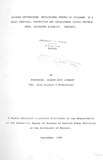| dc.description.abstract | This study examined household and maternal differential
determinants of nutritional status of children aged 18-36 months
in a Child Survival, Protection and Development programme area,
Sengerema division, Tanzania. A total of 356 children and their
mothers from 356 households selected by simple random sampling
and systematic random sampling, respectively, were studied. The
purpose was to identify potential indicators of child nutr itional
status in the area in order to contribute to information required
in alleviation of child malnutrition. Data were collected using
structured questionnaires, key informant and focus group
discussions, and anthropometry.
The results indicate that about 52%, 28%, 4%, and 2% of the
children are stunted, underweight, wasted, and faltering in
growth, respectively. Height for age is positively determined by
wealth base per capita (p<0.005), per capita expenditure on nonfoods
and maternal height (p<0.05). The significant positive
determinants of weight for age are per capita expenditure on
non-foods, frequency of child feeding, child morbidity status,
and maternal height (p<0.005), per capita wealth base (p<O.Ol),
and quality status of living house (p<O. 05), whereas age of
weaning is a negative determinant of weight for age (p<0.005).
The significant positive determinants of weight for height are
child morbidity status, age of the child, per capita expenditure
on non-foods, frequency of child feeding (p<O. 005), quality
status of living house, maternal Body Mass Index and maternal
status of living house, maternal Body Mass Index and maternal
marital status (p<O.05). The negative determinants of weight for
height are age of weaning (p<O.005) and maternal ownership of an
income activity (p<O.05). Weight growth velocity is positively
determined by child age (p<O.005), whereas per capita
expenditure on food, maternal ownership of an income activity and
the reported time mother spends for a return journey to fetch
water, are negative determinants of growth velocity. The other
factors studied showed either no significant, or non-predictive,
association with child nutritional status.
It is concluded that activities aimed at increasing household
wealth base, reducing child morbidity, and improving water
accessibility, quality of living house, maternal nutritional
status and weaning practices, and family life education/services
should be specific priorities for Sengerema division in order to
achieve a substantial improvement in child nutritional status | en |

